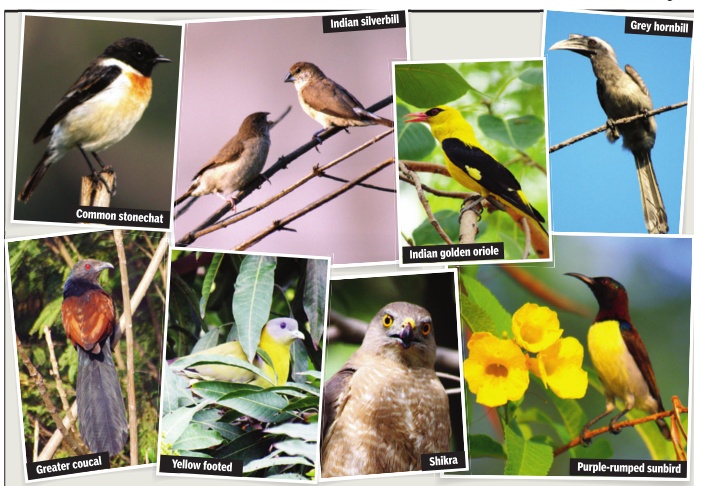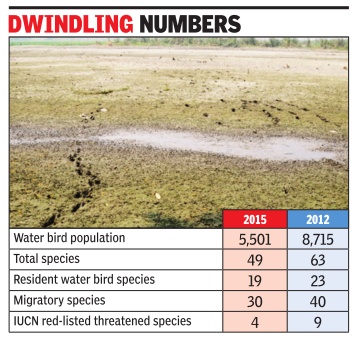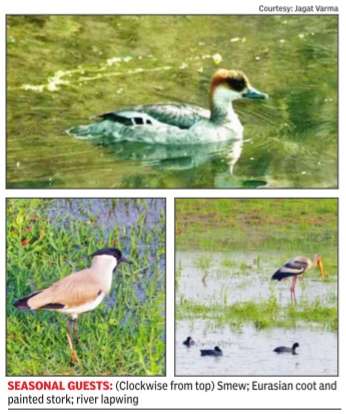Delhi: Birds
This is a collection of articles archived for the excellence of their content. |
Contents |
February 2015: visiting birds
Feb 23 2015
Neha Lalchandani
Rare birds fly into city
Birdwatchers have reported a host of rare birds in the city this season. The sightings, they say, are a result of luck and the proliferation of birdwatchers with better equipment. With the environment of Delhi becoming worse with every passing season, birders say that rare birds have become even more difficult to spot which is why these sightings become extremely important. Kanwar B Singh, a Delhibased birder, says that usually during active western disturbances when it snows in the hills, birds from the Himalayas migrate to the adjoining plains, which is why maybe some of these rare sightings take place in winter.
“The state of the city's wetlands and water bodies has deteriorated over the past few years and has resulted in a fall in the number of species seen here.These sightings have more to do with the increase in number of birders, using more sophisticated equipment and better communication that help in correctly identifying birds,“ he said.
One such rare bird seen in Delhi recently is the Smew, a species of duck which was last reported from the Delhi region in 1922 by Basil-Edwardes. On November 16 last year, Jagat Prakash Verma saw the bird in the Jhajjar district. Birders say it is a significant record as the bird is an extremely rare visitor to India and is a vagrant.
However, according to records of AO Hume, the bird could be seen regularly at the Najafgarh drain till the late 19 th century. The Red-necked phala rope, another rare bird to be spotted in India, was recorded by Sanjay , the bird guide at the Sultanpur bird sanctuary in the beginning of February . This was the first recorded sighting of the bird in almost 35 years. The phalarope migrates from the north Arctic to the tropical seas. “It was sheer chance that it was seen here.
There are a few records of the bird in India in the past few years but in Delhi, it is an extremely lucky sighting,” said Singh.
The Slaty blue flycatcher from the Himalayan forests was seen by Singh on January 31. “It tends to venture into the forests of the Himalayan foothills during winter. However, there has never been any sighting from the Delhi region. I was pleasantly surprised to see one blue-coloured male feeding on the ground next to the jogging track at Nehru Park on January 31,” he said.
Ultramarine flycatcher, another Himalayan species, spends the winter in the forests of Western Ghats. Its recent sightings in the Delhi region were in October 2013 at Sultanpur by Savithri Singh and then in January by at Sundar Nursery by Ratish Nanda.
The Oriental scops owl, a very small bird, was last seen in 1925 by Basil-Edwards till it was spotted once in Palam Vihar in 2013 and then at the Najafgarh drain in January this year.
The Smoky warbler, which is fairly common in east India, was also never conclusively seen around Delhi till this winter. Several birdwatchers saw it at the Basai wetlands this season.
The Lemon-rumped warbler, a Himalayan bird that barely ever descends into the plains, was seen sitting on a tree by Udiyaman Shukla from his balcony near All India Institute of Medical Sciences (AIIMS).
Birds spotted in March 2015
It was birders' day out with rare finds
TIMES NEWS NETWORK The Times of India Mar 09 2015
Sea Duck Spotted In NCR After A Century
It started out as a gloomy morning because of rain and low visibility in some parts of the city but the day turned out to be an ecstatic one for birders. Teams who participated in the Big Bird Day 2015 on Sunday not only spotted a great variety of species but also some extremely rare ones. A team that was birding in Jhajjar's Bhindawas spotted Smew, a European sea duck that was last seen in NCR between 1920 and 1925.
After close to a century, the birders were thrilled that the small duck species that breeds in northern Taiga of Europe and Asia continues to be seen around Delhi.
Another team that went to the Sultanpur bird sanctuary spotted a White-bellied drongo which is also an important sighting as its population is declining. However, Smew was the highlight of the day . “It was spotted in 1881 by AO Hume, who was a great birder and the founder member of Indian National Congress. In 1922, it was seen near the capital by Basil-Edwardes. Recently, there were also reports of it being spotted in West Bengal's Gajoldoba,“ said Bikram Grewal, one of the organizers of Big Bird Day .
Suresh Sharma, who was part of the team that spotted the Smew, said they also saw a Peregrine falcon and an Indian spotted eagle, thanks to their powerful binoculars. “We spotted 178 species on Sunday . Officials are apathetic towards Bhindawas Bird Sanctuary,“ said Sharma.
About 300 people, divided in to 12-14 teams, participated in this year's Big Bird Day . It is one of the largest birding events in the country where people spend a day birding and then upload a list of their sightings on an online portal called eBird. It was started by the Delhibird group--created by Nikhil Devasar and Bikram Grewal--as an informal event held in February or March every year. The first Big Bird Day was held on February 22, 2004, when 236 species of birds were recorded in NCR. The results for this year will be collated in a week.
At Yamuna Biodiversity Park, a team of 20 participated and spotted 109 species between 8am and 10am. A flock of small Pratincole was also seen in the flood zone of Yamuna. At Aravalli Biodiversity Park, counting started early in the morning. A team of six birders participated and listed 69 bird species.
2015: Sunder nursery

Apr 07 2015
Rare birds return to Sundar Nursery
Neha Lalchandani
A little off the beaten track, adjacent to Humayun's Tomb and next to a busy railway station is Sundar Nursery . Typically, one would expect to go there to buy plants but the 70-acre urban oasis is nowhere close to an ordinary nursery . This garden complex is replete with old trees and dotted with monuments dating back to the Mughal era. And it's after years of conservation work, the nursery , originally known as Azim Bagh, is back to its magnificent self. The revival of Sundar Nursery was taken up in 2007.Most of the land was hidden beneath tonnes of debris. The work of landscaping the nursery, along with restoration of 13 monuments, was taken up in 2009 by the Aga Khan Trust for Culture (AKTC) in partnership with CPWD.
The nursery was established by the British in 1913 to grow and develop plants for the new city of Delhi. It was taken over by the CPWD in 1945. At present, it houses the largest collection of tree species found in capital, including some rare ones.
The focus is also on developing a wide range of habitats within the nursery . It is fast becoming a fascinating site for birdwatching. Officials said the project aims at ecological restoration too.
“The landscape master plan was developed by architect M Shaheer and includes zones for a variety of functions. It has an exclusive zone for ground nesting birds such as peafowl. The complex used to be a key bird habitat till 1970s, but large-scale dumping of construction waste ruined the area. Our aim was to redevelop it with native flora and fauna. At present, the nursery has 1,800 large trees now mapped on a GIS system.Additionally , 5,000 tree saplings of over 200 native species have been planted. These species are mostly fruit-bearing and have been planted to attract more birds,“ said an official.
To develop it as a microcosm of Delhi, efforts are on to replicate the ridge biodiversity, along with khadar (riverine), bangar (alluvial) and dabar (marshy) zones.And since birds have started returning to the nursery , one can spot the black kite, grey hornbills, woodpeckers, yellow-footed green pigeons, spotted owlet, Indian roller, white-throated kingfisher, Eurasian hoopoe, Indian grey hornbill, brown-headed barbet, coppersmith barbet, Hume's leaf warbler, common tailorbird, oriental white eye and green bee eater.
Cormorants and painted storks--with their habitat at nearby Delhi zoo--too frequent the nursery even though many major water bodies are yet to be developed.“Water bodies are being developed to attract more birds.The earth embankments along the water bodies are already seeing kingfishers. In addition to that, denselyplanted zones have been established for ground nesting birds such as peafowl and francolin. These will provide a habitat secure from stray dogs,“ the official said.
Currently , AKTC has 77 species of birds, including ultramarine flycatcher and Eurasian golden oriole, on record in the Sundar Nursery area.
Okhla sanctuary

The Times of India Apr 04 2015
Barrage work leaves Okhla sanctuary dry
Okhla Bird Sanctuary is in a precarious state with vast stretches of its wetlands parched. Water has been diverted because the Uttar Pradesh irrigation department is changing three metal gates at the Okhla barrage. Officials said water would be released back into the wetlands only after April 24. Birders say the change in water levels may impact the habitat. The irrigation department, however, insists that the barrage gates have to be maintained every year. Officials claim that the gates have been corroded because of the poor water quality in Yamuna. “We have to do our annual maintenance work.But this time it will take us longer because three barrage gates have to be changed,“ said one of them.
But birders are worried that the seasonal guests will give Okhla a miss. “April onwards the breeding season starts for resident water birds like spot-billed duck, purple swamphen, little grebe, purple heron, common moorhen and others. Some migratory birds from within the country also come for breeding like the lesser whistling duck or streaked weaver. I think now they have to abandon the sanctuary , skipping their annual breeding,“ said T K Roy ,a birder and Asian Waterbird Census coordinator for NCR.
“I know for sure that the authorities managing the sanctuary don't want any birders to go there. This is mainly because of their nexus with the builders and possibly they want to kill the sanctuary as well. Once I was charged Rs 500 just to take a camera inside,“ said a birder on condition of anonymity . There are also complaints of too many vehicles being allowed to use the road inside the sanctuary and very little ecological buffer area that can preserve the habitat. Birders say about seven to eight years ago close to 50,000 ducks could be seen during the season.
The only saving grace this time is that the maintenance work by the irrigation department has been rescheduled to March and April instead of October. In 2013, it was carried out in October-November when migratory species start arriving from Central Asia and Europe. Birders stressed that if maintenance is absolutely unavoidable then it should be wrapped up within a few days and not stretch up to a month.
“We had requested them not to carry out the work in October-November that's why they are doing it now. All the migratory birds are gone except northern shoveler and Eurasian wigeon. We should understand that the wetland and the sanctuary were created because of this barrage and it has to be maintained,“ said a UP forest department official.

